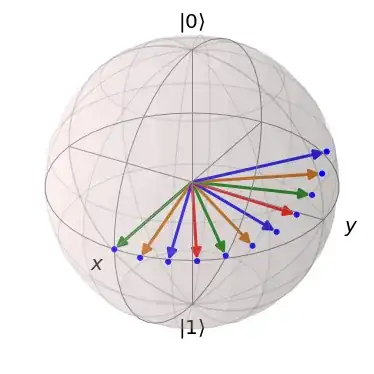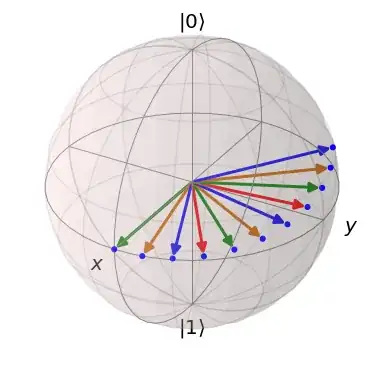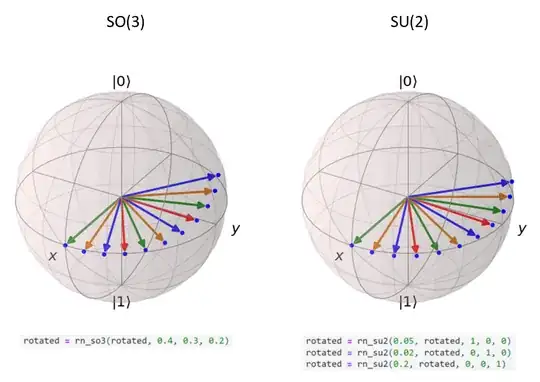Let us first introduce two fundamental functions for coordinate transformations:
def to_spherical(state):
r0 = np.abs(state[0])
ϕ0 = np.angle(state[0])
r1 = np.abs(state[1])
ϕ1 = np.angle(state[1])
r = np.sqrt(r0 ** 2 + r1 ** 2)
θ = 2 * np.arccos(r0 / r)
ϕ = ϕ1 - ϕ0
return [r, θ, ϕ]
def to_cartesian(polar):
r = polar[0]
θ = polar[1]
ϕ = polar[2]
x = r * np.sin(θ) * np.cos(ϕ)
y = r * np.sin(θ) * np.sin(ϕ)
z = r * np.cos(θ)
return [x, y, z]
I am rotating stepwise a qubit using the $SO(3)$ group as follows:
import qutip as qt
from qutip.qip.operations import rx
import numpy as np
def rn_so3(state, theta, phi, delta):
rn_mat = qt.Qobj(
[[np.cos(delta/2) - (0+1j)np.cos(theta)np.sin(delta/2),
-(0+1j)np.exp(-(0+1j)phi)np.sin(delta/2)np.sin(theta)],
[-(0+1j)np.exp((0+1j)phi)np.sin(delta/2)np.sin(theta),
np.cos(delta/2) + (0+1j)np.cos(theta)np.sin(delta/2)]]
)
r_state = (rn_matstate)(rn_mat*state).dag()
return(r_state)
b = qt.Bloch()
b.clear()
b.make_sphere()
states = []
points = []
alpha = 1/np.sqrt(2)
beta = 1/np.sqrt(2)
s = np.array([alpha,beta])
state = qt.Qobj(s)
states.append(state)
Ψ = [complex(alpha, 0), complex(beta, 0)]
polar = to_spherical(Ψ)
pnt = to_cartesian(polar)
points.append(pnt)
rotated = state
for i in range(0,10):
rotated = rn_so3(rotated, 0.4, 0.3, 0.2)
pnt = [(qt.sigmax()rotated).tr(), (qt.sigmay()rotated).tr(), (qt.sigmaz()*rotated).tr()]
states.append(rotated)
points.append(pnt)
b.add_states(states)
np_points = np.array(points)
b.add_points([np_points[:,0], np_points[:,1], np_points[:,2]])
b.show()
This seems to work and the corresponding output looks as follows:
To retrace elementary relationships and "mechanics" that happens under the hood, I am now trying to achieve the same using the $SU(2)$ group and coordinate transformations:
def rn_su2(θ, ϕ):
return (np.sin(θ)*np.cos(ϕ)*qt.sigmax() + np.sin(θ)*np.sin(ϕ)*qt.sigmay() + np.cos(θ)*qt.sigmaz())
b = qt.Bloch()
b.clear()
b.make_sphere()
states = []
points = []
alpha = 1/np.sqrt(2)
beta = 1/np.sqrt(2)
s = np.array([alpha,beta])
state = qt.Qobj(s)
states.append(state)
Ψ = [complex(alpha, 0), complex(beta, 0)]
polar = to_spherical(Ψ)
pnt = to_cartesian(polar)
points.append(pnt)
rotated = state
for i in range(0,10):
#
# Here seems to go something wrong
#
rotated = rn_su2(0.2i, 0.3i)
states.append(rotated)
#polar = to_spherical(rotated)
#pnt = to_cartesian(polar)
points.append(pnt)
b.add_states(states)
np_points = np.array(points)
b.add_points([np_points[:,0], np_points[:,1], np_points[:,2]])
b.show()
Here I have some fundamental error and would appreciate any help or hint. The full notebook is also available here at GitHub.
Update 2022-03-19: I implemented the $SU(2)$ rotation according the useful hint in the comment. It looks better, but unfortunatelly the state lies not on the Bloch Sphere anymore:
def rn_su2(θ, state, nx, ny, nz):
Ψ = [state.data[0,0], state.data[1,0]]
arr = to_spherical(Ψ)
s_θ = arr[1]
s_ϕ = arr[2]
M_q = np.sin(s_θ)*np.cos(s_ϕ)*qt.sigmax() + np.sin(s_θ)*np.sin(s_ϕ)*qt.sigmay() + np.cos(s_θ)*qt.sigmaz()
U_n = qt.qeye(2)*np.cos(θ/2) -1j*(nx*qt.sigmax()+ny*qt.sigmay()+nz*qt.sigmaz())*np.sin(θ/2)
r_state = U_n*M_q*U_n.dag()
return r_state
Update 2022-03-20: Thanks to the unveiling answer here, the $SU(2)$ rotations look good and correct:
What remains is the question: How do you have to rotate so that both point sequences look the same? In the $SO(3)$ implementation case I used rotated = rn_so3(rotated, 0.4, 0.3, 0.2) and to get an almost same looking picture, by trial and error, I obtained for the $SU(2)$ implementation:
rotated = rn_su2(0.05, rotated, 1, 0, 0)
rotated = rn_su2(0.02, rotated, 0, 1, 0)
rotated = rn_su2(0.2, rotated, 0, 0, 1)
How are the angles to be used related in both cases?


